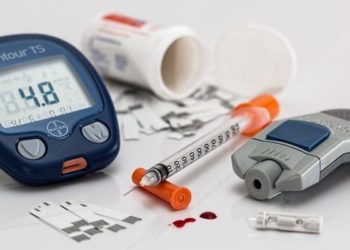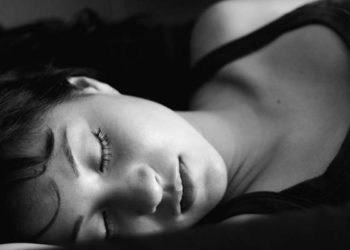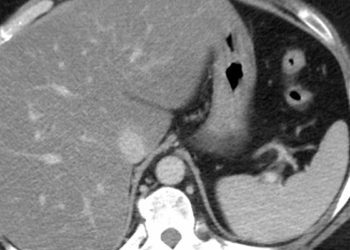Wellness Check: Sleep
Atypical deglutition associated with obstructive sleep apnea in children
1. In children with obstructive sleep apnea syndrome, atypical deglutition was associated with more severe apnea.
2. Atypical deglutition was more strongly associated with increased pharyngeal collapsibility and altered facial measurements in children.
Evidence Rating Level: 2 (Good)
Tongue thrusting is a normal phenomenon in neonates, but lack of cessation by age 6 results in atypical deglutition. Atypical deglutition may be linked to pediatric obstructive sleep apnea (OSAS). As a result, correction of atypical deglutition through myofunctional therapy could improve OSAS symptoms. However, the relationship between atypical deglutition and OSAS is unclear.
This cross-sectional study assessed the prevalence of atypical deglutition in children with OSAS. 90 children aged 6-18 years, with moderate to severe OSA determined by night polysomnography, were included in the study. Each participant’s swallowing pattern was identified by an orthodontist and classified into two categories: typical and atypical deglutition. The only exclusion criterion was the presence of a syndromic disease. All children underwent a systematic evaluation which included data such as height, weight, neck circumference, and symptoms of snoring and/or sleep-disordered breathing. The primary outcome was to measure the prevalence of atypical deglutition in children with moderate to severe OSAS.
In children with atypical deglutition compared with those with typical deglutition, labial incompetence, narrow maxilla, anterior open bite, low tongue position, and the presence of asymmetry on the frontal examination of the face were all more frequent. Higher rates of atypical deglutition were seen in children with mixed or permanent dentition with OSAS, suggesting an association between OSAS and atypical deglutition. A limitation of the study is the modified use of the term “atypical deglutition” which has not yet been clinically evaluated in other studies. Nonetheless, the study suggests that identifying atypical deglutition in children with OSAS can help guide therapeutic management.
Online self-help intervention improves acute insomnia severity
1. In patients with acute insomnia, an online behavioral self-help intervention was effective in reducing insomnia severity within one week.
2. Patients with acute insomnia provided with a two-page PDF self-help leaflet reported reduced insomnia severity index (ISI) scores from baseline at one-week, one-month, and three-month follow-up periods.
Evidence Rating Level: 1 (Excellent)
Insomnia is a highly prevalent sleep disorder associated with negative physical and psychological health outcomes. Pharmacological treatments for insomnia such as benzodiazepines are associated with negative side effects. Cognitive behavioral therapy (CBT) is an effective first-line treatment, but limited by a lack of qualified providers. An online self-help leaflet enables large-scale intervention delivery. However, the effectiveness of such an intervention for individuals with acute insomnia is unknown.
This stratified randomized controlled trial tested the effectiveness of a self-help leaflet on insomnia severity. 344 participants entered into the study, including 103 good sleepers and 241 acute insomnia participants as defined by the Diagnostic and Statistical Manual of Mental Disorders (DSM-5). Healthy good sleepers were defined as not having any current sleep problems. Individuals were not eligible to participate if they self-reported chronic sleep problems persisting >3 months, actively using another treatment for their sleep disorder, or reported a history of head injury, diagnosis of schizophrenia, epilepsy, or personality disorder. Acute insomnia participants were randomized into an intervention or waitlist group, and good sleepers were randomized into an intervention or no intervention group. Complete baseline ISI data was obtained for 277 participants (82 good sleepers and 195 acute insomnia). The intervention involved a self-help leaflet that explained the principles of stimulus control, cognitive control, and imagery distraction techniques that were broken down into the “three D’s:” Detect, Detach, and Distract. Complete ISI follow-up data was obtained at one week, one month, and three months. The primary outcome measured was ISI scores.
The study showed that acute insomnia participants who received the online self-help intervention had a significantly reduced insomnia severity between baseline and all follow-up time points. Furthermore, the intervention was shown to improve anxiety and depression levels in the short term. No beneficial effects on sleep were recorded in good sleepers. A limitation of the study is the lack of an active control group, which may allow the placebo effect to influence results. Nonetheless, this study still shows promising preliminary results on the effectiveness of an online self-help intervention in rapidly reducing acute insomnia.
Behavioral therapy improves insomnia severity in patients with shift work disorder
1. In healthcare workers experiencing shift work disorder, behavioral therapy was effective in improving insomnia severity after 2 weeks.
2. Patients receiving behavioral therapy for treatment had greater improvements in daytime sleep than the control group.
Evidence Rating Level: 1 (Excellent)
A common consequence of shift work is insomnia and sleepiness which is known as shift work disorder (SWD). Most treatments for SWD are focused on pharmacotherapy such as hypnotics to extend daytime sleep and stimulants to alleviate sleepiness. However, cognitive behavioral therapy has recently been shown to improve sleep outcomes. This study evaluates the effectiveness of behavioral therapy for SWD (BT-SWD).
This randomized control trial tested the effectiveness of BT-SWD on insomnia severity in shift workers working in the province of Quebec’s health network. 43-night shifters workers experiencing SWD randomized to either behavioral therapy or wait-listing control group were included if they worked at least 5 nights out of 14 days between 24:00 hours and 08:00 hours (+/-1 hr) for at least 3 months and were diagnosed with SWD. Participants with symptoms of sleep disorder other than SWD, major depression with suicidal ideation, psychotic disorder or any disorder resulting from substance abuse, having consumed hypnotics more than 3 times per week in the last month, and consuming more than 10 cups of coffee (or other stimulants) per day were excluded. BT-SWD involves sleep restriction therapy, stimulus control, and fixed sleep periods in the dark. Therapy involved face-to-face sessions at a sleep laboratory including psychoeducation on sleep, circadian rhythms, and adaptation of sleep restriction and stimulus control for shift workers. Total sleep time, total wake time, and sleep onset latency were derived from participants through sleep diaries. Insomnia symptoms were evaluated with the Insomnia Severity Index (ISI). The primary outcome measured was insomnia severity for daytime and nighttime sleep.
BT-SWD participants had a significantly greater decrease in daytime insomnia severity and an increase in daytime total sleep time post-treatment than the control group. Those who received behavioral therapy also reported improved sleepiness, anxiety, and depression levels that were maintained at 5 months follow-up. However, this study had limitations such as a high attrition rate. Nonetheless, this study shows that BT-SWD can be used to improve the sleep and mental health of healthcare workers.
Image: PD
©2024 2 Minute Medicine, Inc. All rights reserved. No works may be reproduced without expressed written consent from 2 Minute Medicine, Inc. Inquire about licensing here. No article should be construed as medical advice and is not intended as such by the authors or by 2 Minute Medicine, Inc.







